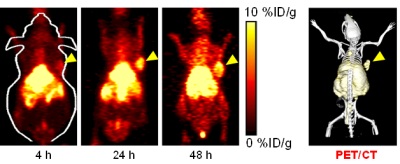


Posted August 6, 2013
Weibo Cai, Ph.D., University of Wisconsin
 Prostate tumors have many differences from patient to patient, and even within an individual patient, multiple areas of tumor can differ from each other in many ways. This variance, especially within a single patient, creates significant challenges for successfully treating prostate cancer with a one-size-fits-all approach, and is the reason researchers have been pushing towards more personalized medicine. Enhanced, non-invasive imaging on a molecular level would be a key advancement for prostate cancer detection and diagnosis, and would be even further useful in ensuring the delivery of molecularly targeted drugs to the right patients at the right time with the right dose. The research team led by Dr. Weibo Cai at the University of Wisconsin, with funding from a FY10 PCRP Idea Development Award - New Investigator Option, is using their extensive experience in molecular imaging and cancer therapy to address this important issue.
Prostate tumors have many differences from patient to patient, and even within an individual patient, multiple areas of tumor can differ from each other in many ways. This variance, especially within a single patient, creates significant challenges for successfully treating prostate cancer with a one-size-fits-all approach, and is the reason researchers have been pushing towards more personalized medicine. Enhanced, non-invasive imaging on a molecular level would be a key advancement for prostate cancer detection and diagnosis, and would be even further useful in ensuring the delivery of molecularly targeted drugs to the right patients at the right time with the right dose. The research team led by Dr. Weibo Cai at the University of Wisconsin, with funding from a FY10 PCRP Idea Development Award - New Investigator Option, is using their extensive experience in molecular imaging and cancer therapy to address this important issue.
Dr. Cai and his team have been working on developing a platform that would be used for both non-invasive imaging and molecularly targeted therapy. This platform is built around the insulin-like growth factor 1 receptor (IGF1R), the expression level of which is increased in some prostate cancer tumors and can be used for both imaging and therapeutic applications simply with the use of different radioisotopes for diagnostic or therapeutic purposes. This dual functionality can be exploited for major advancements in the clinical management of prostate cancer, since IGF1R-based agents would enable more accurate patient selection for IGF1R-targeted clinical trials, effective monitoring of therapeutic responses, and provide new candidate anticancer drugs.
Building on the successful results from his PCRP-funded project, Dr. Cai plans to continue moving this IGF1R platform closer to use for patients by using IGF1R-targeted PET imaging tracers as diagnostic and prognostic agents, and developing new radiotherapy agents. His goal is that this new agent would allow for initial screening of prostate cancer patients to identify those that might best benefit from IGF1R-based treatment, and subsequently treat those individuals with the IGF1R therapeutic agent by simply substituting the imaging isotope with a therapeutic isotope. This "scout-and-treat" strategy is expected to give significantly higher response rate in prostate cancer patients than conventional cancer therapies.

Figure 1. Serial coronal positron emission tomography (PET) images of DU145 prostate cancer xenograft-bearing mice after intravenous injection of a 64Cu-labeled anti-IGF1R monoclonal antibody. A PET/CT fused image of the mouse at 24 h post-injection is also shown. Arrowheads indicate the DU145 tumor.














